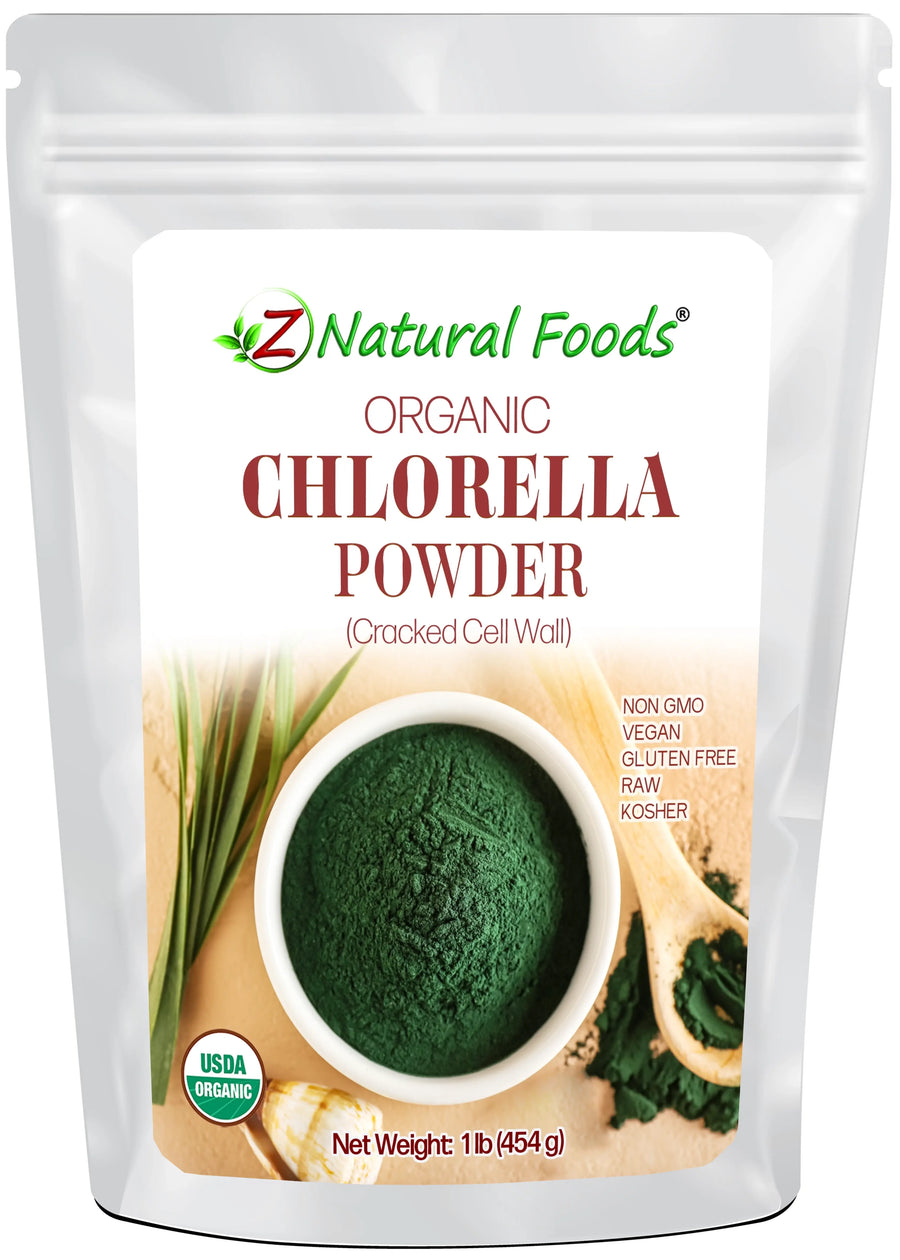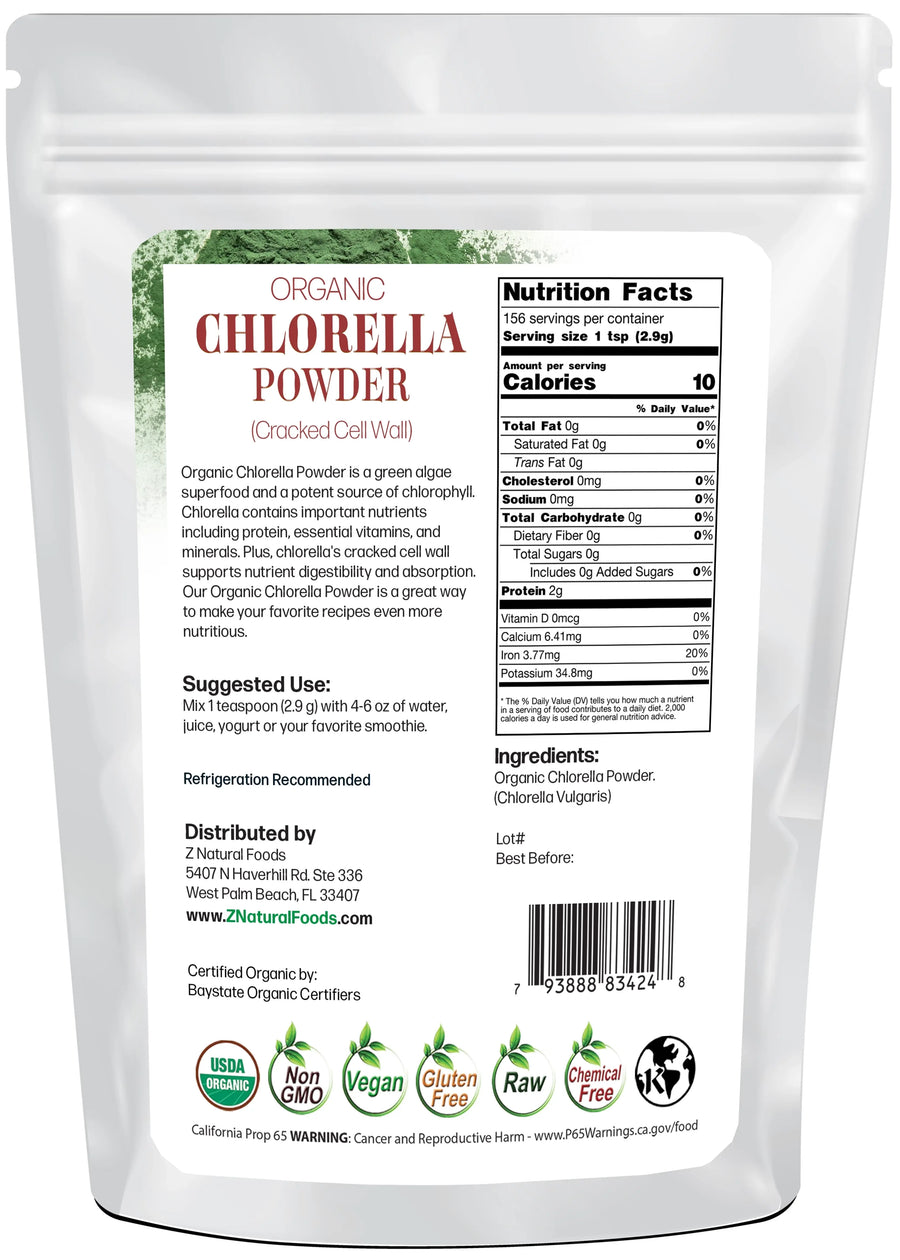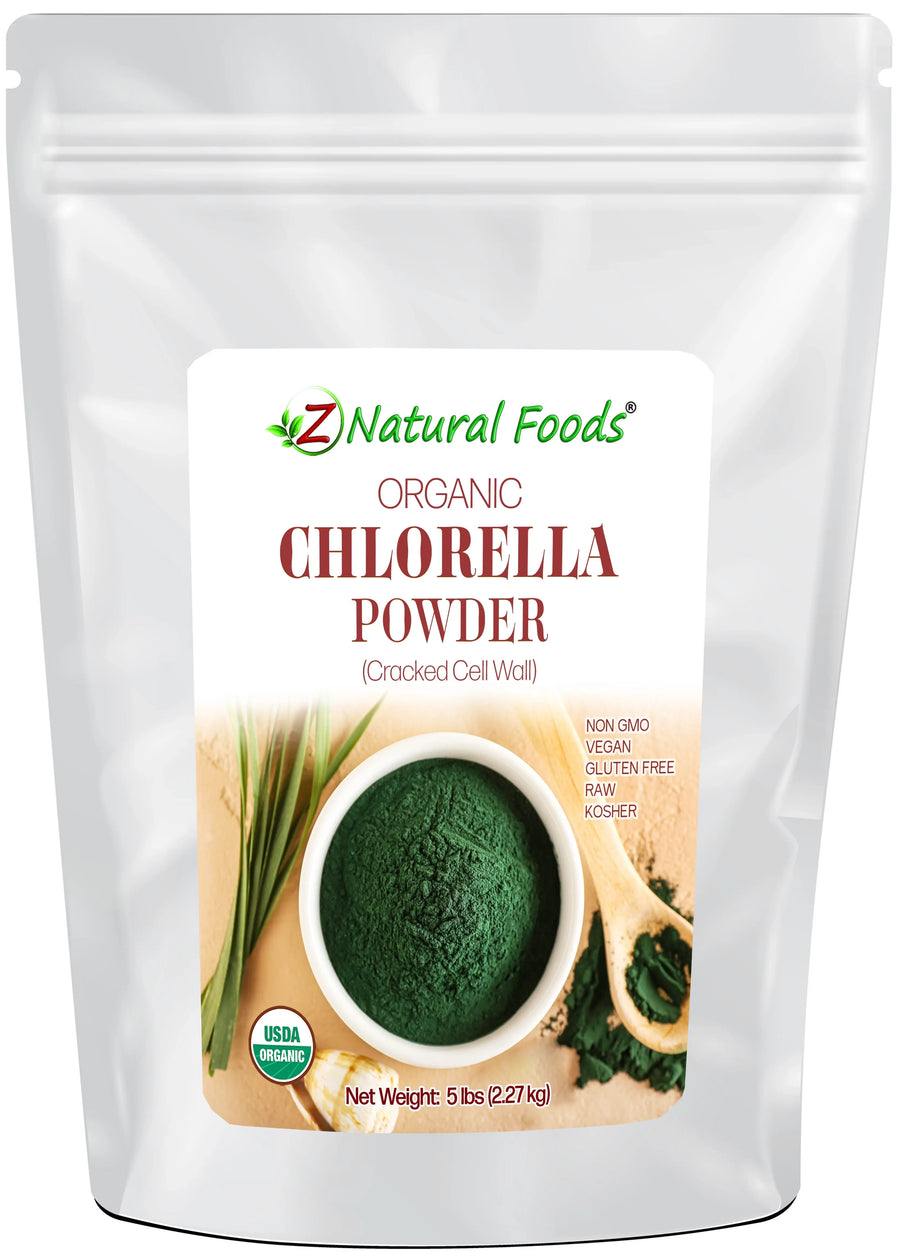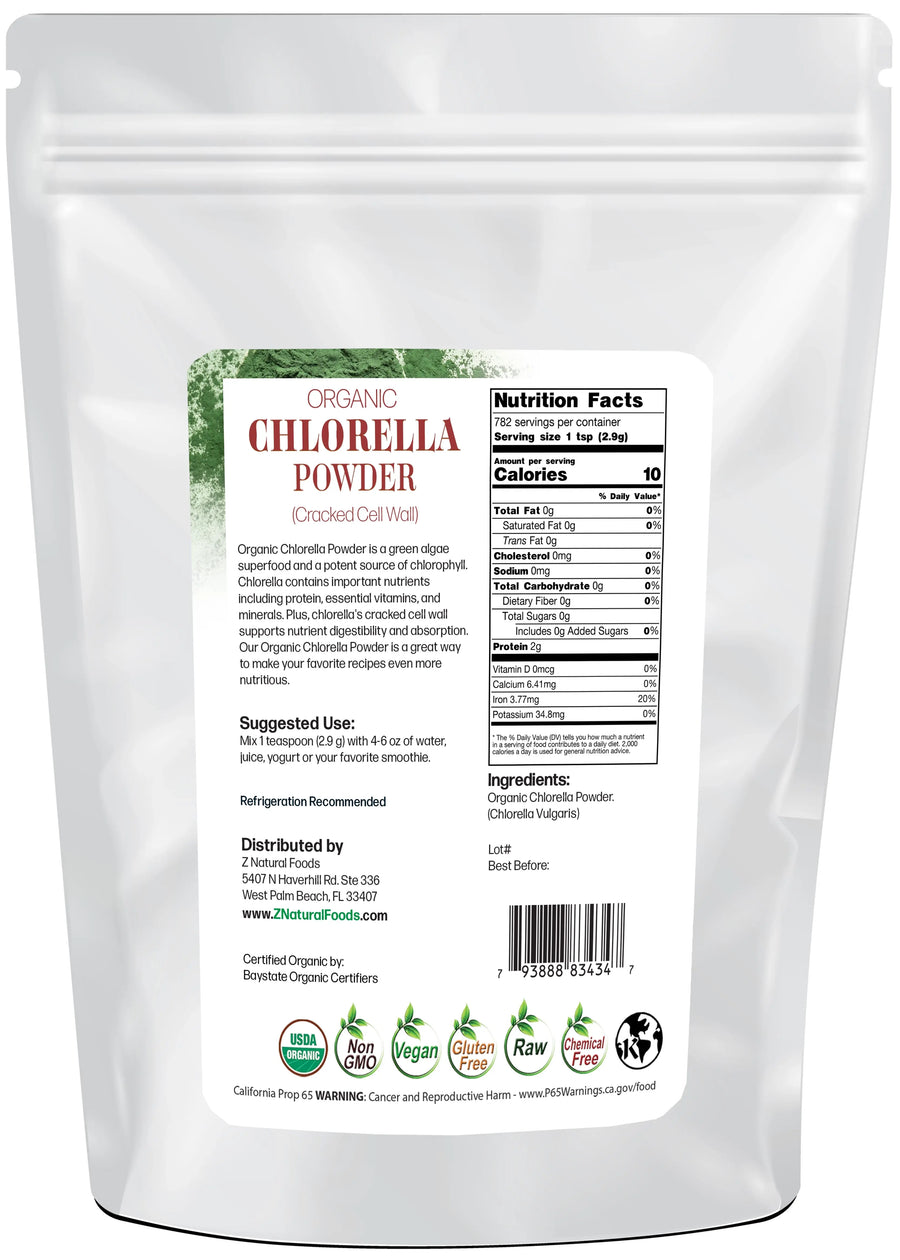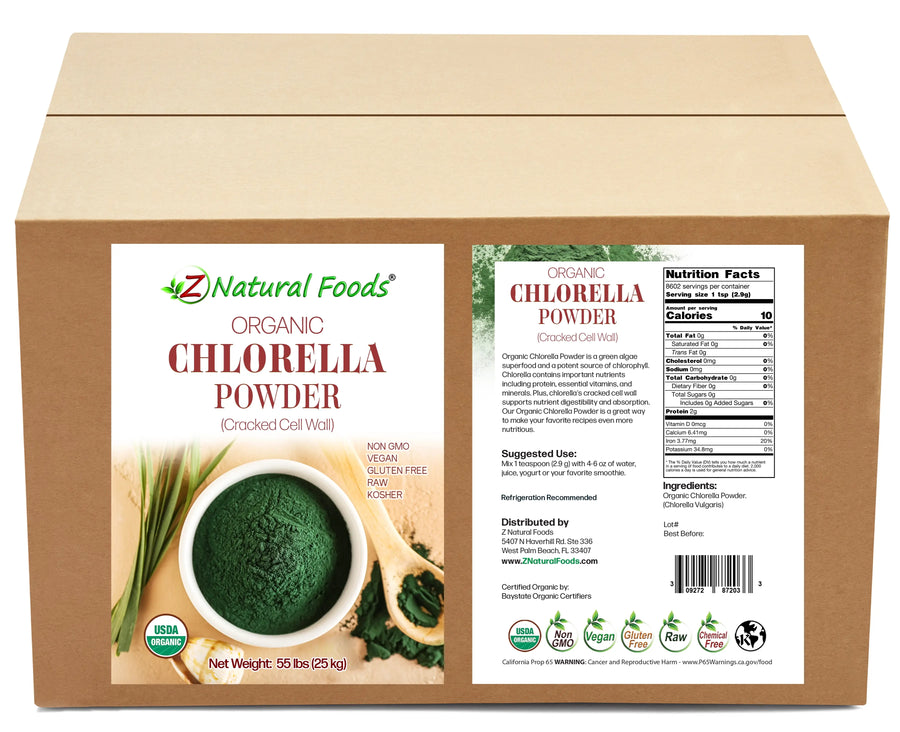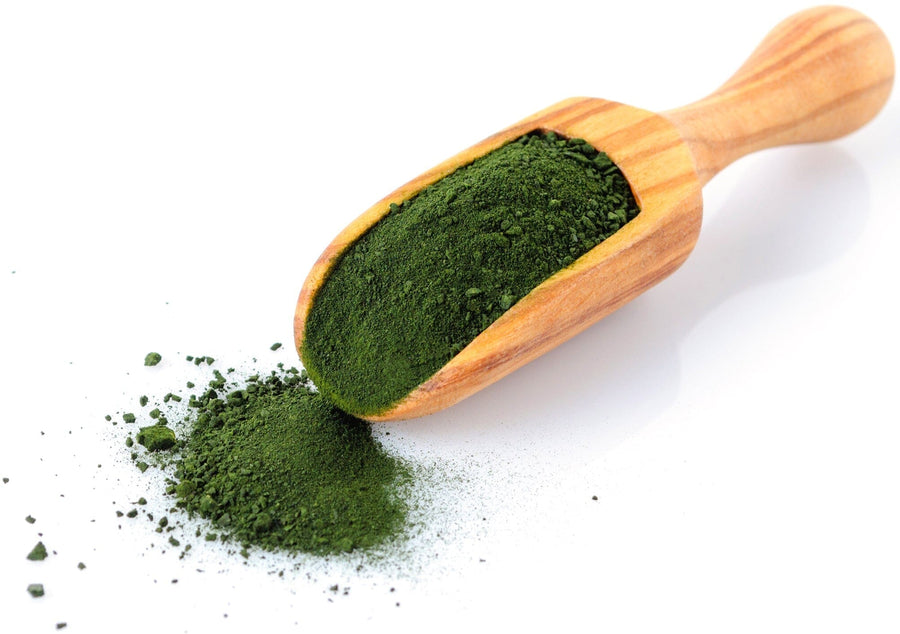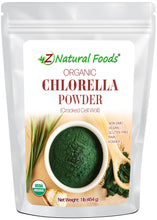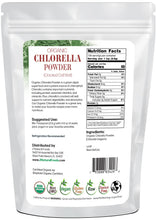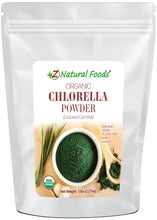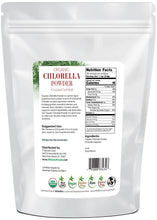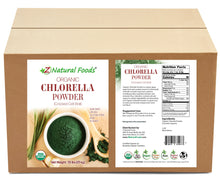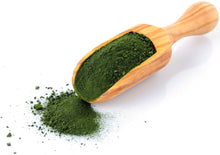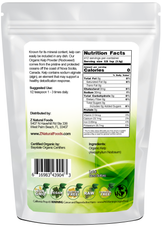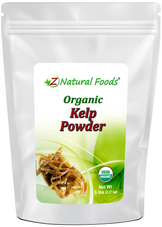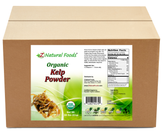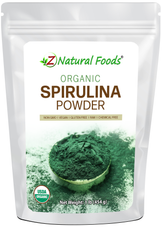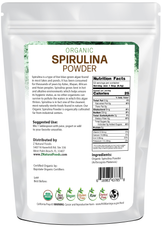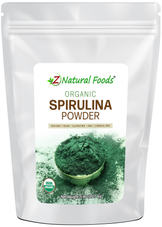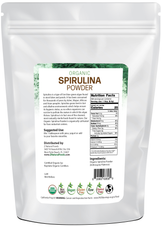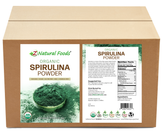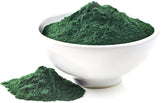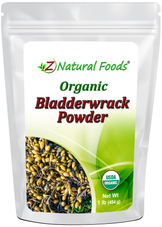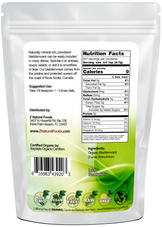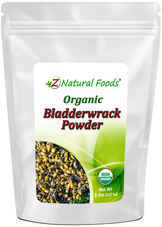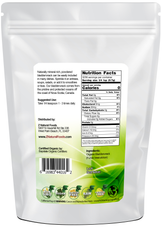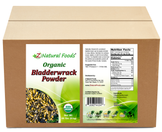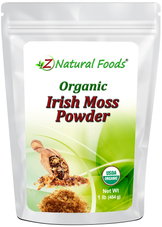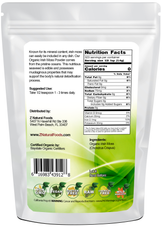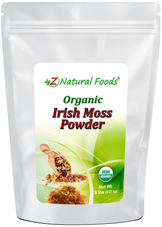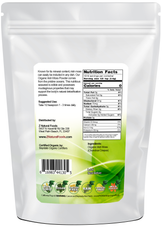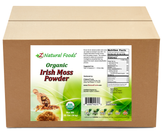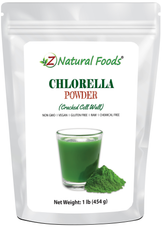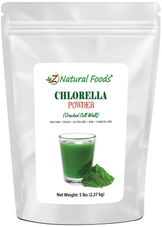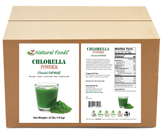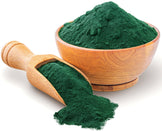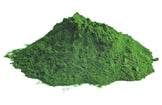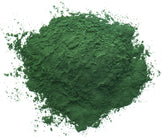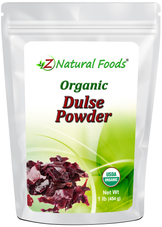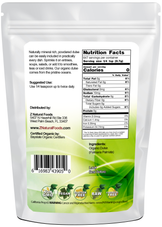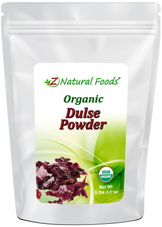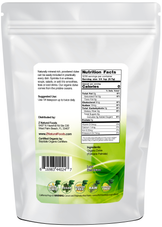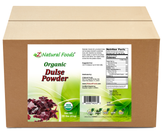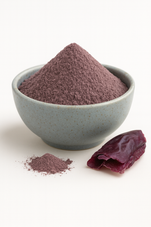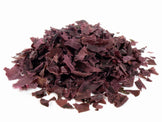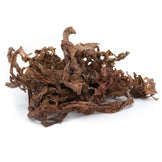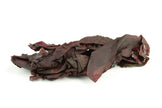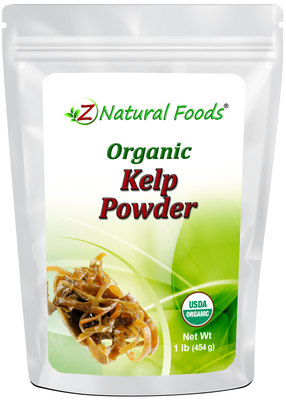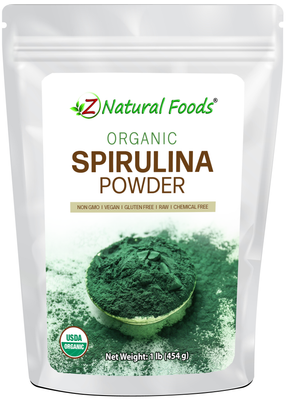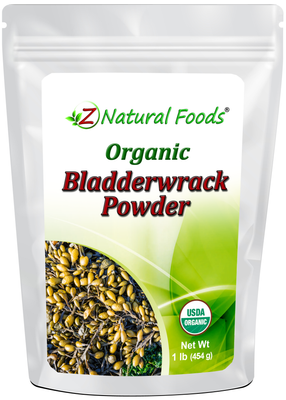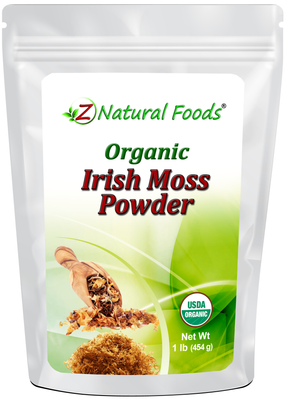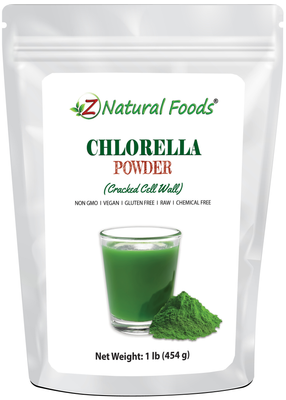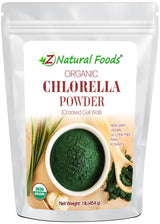About Product
Chlorella Powder (Cracked Cell Wall) is a green algae powder known for its bold color and fresh, earthy taste. Traditionally used in various cultures, it has become a versatile ingredient enjoyed around the world.
Perfect for mixing into smoothies, juices, soups, or baked goods, chlorella powder adds both natural green color and plant-based variety to recipes. Convenient and shelf-stable, it’s an easy way to bring the essence of green algae into everyday cooking.
Some research suggests that Chlorella may contain the following constituents:
- Protein, Essential Fatty Acids, Carbohydrates
- Minerals: Magnesium, Phosphorus, Zinc, Iodine
- Vitamins: Vitamin C, Thiamin, Riboflavin, Niacin, Pantothenic Acid, Vitamin B-6, Folate, Biotin, PABA, Choline, Inositol, Beta carotene, Vitamin A (IU), Vitamin E, Lutein, Alpha- Carotene, Tocopherols
- Amino Acids: Isoleucine, Leucine,. Lysine, Methionine, Glycine, Phenylalanine, Tryptophan, Arginine, Histidine, Alanine, Aspartic Acid, Glutamic Acid, Proline, Serine, Valine, Threonine, Alanine
- Phytochemicals: Chlorophyll A & B, Chlorella Growth Factor, Sporopollenin, Chlorellin
This product is 100% natural and minimally processed. Taste, smell, texture, and color vary from batch to batch.
Suggested Use: Mix one teaspoon (2.9g) with 4-6 oz of water, juice, yogurt, or your favorite smoothie.
Mixing suggestion: To increase flavor and nutritional profile, combine our organic carrot, beet powders, and a fresh apple in a smoothie.
Botanical Name: Chlorella vulgaris.
Other Names: Algae Verte d’Eau Douce, Bulgarian Chlorella, Bulgarian Green Algae, Chinese Chlorella, Chlorella Algae, Chlorelle, Clorela, Freshwater Green Algae, Freshwater Seaweed, Green Alga, Green Algae, Japanese Chlorella, Seaweed, Yaeyama Chlorella.
Parts Used: Cracked Cell Wall Chlorella.
Ingredients: Cracked Cell Wall Chlorella.
Origin: Grown and dried in China and packaged with care in Florida, USA.
How to Maintain Optimum Freshness
- This product is packaged in airtight stand-up, resealable foil pouches for optimum freshness.
- Once opened, push the air out of the pouch before resealing it to preserve maximum potency.
- Keep your powder in a cool, dark, dry place.
This product is 100% natural and minimally processed:
Taste, smell, texture, and color vary from batch to batch. Go here to learn why our products may naturally vary.
The important protections we take to bring you safe and nutritious superfoods:
Please go here to discover the essential steps we take to deliver fresh, quality nutrition.
Bulk Quantities?
Need to order a large quantity of our products? We are happy to help! Please get in touch with our Bulk department to discuss the details.
* Product packaging, pictures, and origin may vary.
Sources & References
1. Aksu, Z.; T. ; The usage of chlorella vulgaris in waste water treatment containing heavy metal irons. Proc. 4th Eur. Cong. Biotech, 2, 80-83, 1987.
2. Ben-Basset,D.; Mayer, A.M.: Reduction of mercury chloride by chlorella: Evidence for a reducing factor. Physiol. Pl., 40, 157-162, 1977.
3. De Filippis, L.F.; The effect of sub-lethal concentrations of mercury and zinc on chlorella IV characteristics of a general reducing enzyme system for metallic irons. Z. Pflanzenphysiol. 86S: 339-352, 1978.
4. De Fillips, L.F.; Pallaghy, C.K.: The effect of sub-lethal concentrations of mercury and zinc on chlorella III. Development and possible mechanisms of resistance to metals. Pflanzenphysiol. 79S: 332-335, 1976.
5. Jensen, S.; Jenelov, A.: Biological methylation of mercury in aquatic organisms. Nature, 223: 753, 1969.
6. Nakajima, A; Horikoshi, T; Sakagushi, T.: Recovery of uranium by immobilised micro-organisms. Evr. J. Appl. Microbiol. Biotech, 16: 88-91, 1982.
7. Shieh, Y.J.; Barger, J: Uptake of mercury by chlorella and its effect on potassium regulation. Planta, 109: 49-60, 1973.
8. Sneddon. J.; Pappas, C.P: Binding and removal of metal irons in solution by an algae biomass. Am. Environ. Lab, 10: 9-13, 1991.
9. Wilkinson, S.C.; Goulding, K.H.; Robinson, P.K. Mercury removal by immobilised Algae (Chlorella) in batch culture systems. Journal of Applied Phycology, 2:223-230, 1990.
10. Pore, R.S.; Detoxification of chlordecore poisoned rats with chlorella and chlorella-derived sporopollenin. Drug. Chem. Toxicol, 7: 57-71, 1984.
11. Kojima, M.; Kasajima, t.; Imai, Y., et al: A new chlorella polysaccharide and its accelerating effect on the phagocytic activity of the reticuloendothelial system. Recent Adv. Res., 13, 11, 1973.
12. Merchant, R.E.; Rice, C.C.; Young, H.F.: Dietary chlorella pyrenoidosa for patients with malignant glioma: Effects on immunocompetence, quality of life, and survival. Phytotherapy Research, Vol. 4, No. 6, 220-230, 1990.
13. Tanaka, K.; Koga, T.; Konishi, F., et al: Augmentation of host defence by a unicellular alga, chlorella vulgaris, to escherichia coli infection. Infect. Immun., 53: 267-271, 1986.
14. Ibusuki, K.; Minamishima, Y.: Effect of chlorella vulgaris extracts on murine cytomegalovirus infections. Nat. Immun. Cell Growth Regul., 9 : 121-128, 1990.
15. Kanazawa Medical College Dept. of Serology: Effects of various preparation made from chlorella pyrenoidosa cells on the defence mechanism (immune Resistance), 66-70, 1980.
16. Komiyama, K.: Hirokawa, Y.; Mocota, T., et al: An acidic polysaccharide chlon A, from chlorella pyrenoidosa. Anti-tumour activity and immunological response, Chemotherapy, 34: 302-307, 1986.
17. Konishi, F.; Tanaka, K. ; Himeno, K., et al: Anti-tumour effect induced by a hot water extract of chlorella vulgaris: Resistance to meth-A tumour growth mediated by CE-induced polymorphonuclear leucocytes. Cancer Immunology and Immunotheraphy, 19 : 73-78, 1985.
18. Kuniaki, T.; Yoshifumi, T.; Tsuruta, M. et al: Oral administration of chlorella vulgaris augments concomitant anti-tumour immunity. Immuno-pharmacology and Immunotoxicology, 12 (2): 277-291, 1990.
19. Miyazawa, Y.; Murayama, T.; Ooya, N. et al: Immunomodulation by unicellular green algae (chlorella pyrenoidosa) in tumour-bearing mice. Journal of Ethnopharmacology, 24, 135-146, 1988.
20. Tanaka, K.; Konishi, F.; Himeno, K: Augmentation of anti-tumour resistance by a strain of unicellular green algae, chlorella vulgaris. Cancer Immunology and Immunotheraphy, 17: 90-94, 1984. 83.
21. Morita, K., Matsueda T., Iida, T., Hasegawa, T.: Chlorella accelerates dioxin excretion in rats. Journal of nutrition 129 (9): 1731-6, 1999.
22. Kunimasa M., Masahiro O., Hasegawa, T.: Chlorophyll derived from chlorella inhibits dioxin absorption from the gastrointestinal tract and accelerates dioxin excretion in rats. Environmental Health Perspectives 109: 289, 2001.
23. Merchant, R., Andre, C.: A review of recent clinical trials of the nutritional supplement chlorella pyrenoidosa in the treatment of fibromyalgia, hypertension, and ulcerative colitis. Alternative Therapies 7: 79, 2001.
24. Japan Food Research Laboratories, Analysis Certificate No. 100021448-010, 2000.
25. Wong, S.L., et al..: Detection of toxic organometallic complexes in wastewaters using algal assays. Arch. Environ. Contam. Toxicol., 32: 358-366, 1997.
26. Travesio, L. Canizares, R.O.: Heavy metal removal by microalgae. Bull. Environ. Contam. Toxicol 62: 144-151, 1999.
27. Klinghardt, D.: Schwermetalle und chronische Erkrankungen. Hier&Jetzt 3: 10-13, 2000.
28. Urey, J.C., et al.: Bioconcentration of four pure PCB Isomers by chlorella pyrenoidosa. Bull. Envir. Contam. Toxicol 16: 81-85, 1976.
29. Palacios, Mayorga S., et al.: Algunas modificationes al aislamiento y cultivo de chlorella vulgaris Beijerinck. Rev. Lat-amer. Microbiol 19: 95-103, 1977.
30. Chang, J.: Wild swans " three daughters of China. New York, Simon Schuster, 1991.
31. Spoehr, H.A. Milner, H.W.: Plant. Physiol. 24: 120f., 1949.
32. Tamiya, N., et al.: Preliminary experiments in the use of chlorella as human food. Food Technology Vol. VIII, 4: 179-182, 1954.
33. Hagino et al.: Effect of chlorella on fecal and urinary cadmium excretion in Itai-itai. Jap. J. Hyg. 30: 77, 4/1975.
34. Mandliche Mitteilung wahrend der 3rd International Exhibition & Conference of Vitafoods International, 03.-05.05.2000 in Genf, Schweiz.
35. Isidori, A., et al.: A study of human growth hormone (HGH) release in man after oral administration of amino acids. Current-Medical Research and Opinion, 7, 1981.
36. Fried, R./ Merrel, W.C.: The arginine solution, New York: Warner Books, 1999.
37. Lombard, J. Germano, C.: The brain wellness plan, New York: Kensington Publishing, 1997.
38. Kojima, M. Shishido, K., et al.: A clorella polysaccharide as a factor stimulating RES activity. J. reticuloendothel Soc., 14(2): 192-208, 1973.
39. Kojima, M. Kasajima, Y.: A new chlorella polysaccharide and its accelerating effect on the phagozytose activity of the reticuloendothelial system. Recent Adv. R.E.S., 13: 11, 1973.
40. Matusiak, K. Krzywicka, A.: Influence of the extract of chlorella vulgaris on growth of fungi. Acta Microbiologica Polonica Ser. B, 7(24), No.1: 51-54, 1975.
41. Forest, W.: Ullmanns Enzyklopädie der technischen Chemie, München/Berlin Verlag Urban & Schwarzenberg, 136-141, 1956.
42. Popp, F.A.: Das Licht in unseren Zellen, 6.Auflage, Verlag Zweitausendeins, 1995.
43. Koch, H.P. Hahnler, G.:Chlorophyll " Blattgran als Arzneimittel, Deutscher Apotheker Verlag, 1995.
44. Economics Club: Latest report on functional study of chlorella. Nihonbashi, Japan (unveraffentlicht), 25.06.1997.
45.Yasukawa, K. Akihisa, T., et al.: Inhibitory effects of sterols isolated from chlorella vulgaris on 12-0-Tetradecanoylphorbol-13-acetate-induced inflammation and tumor promotion in mouse skin. Biol. Pharm. Bull. 19(4): 573-576, 1996.
46.Vortrag von Dr. Tahao Iida (Health Ecology Research Lab., Fukoka, Japan [July 9-10th, 1998]: Chlorella has remarkable effects of excreting dioxin out of the body. Sonderdruck aus Health Life Business Magazine 179, 1998.
47. Jensen, B.: Chlorella, Jewel of the Far East. Escondido/CA, USA: Bernard Jensen Publisher, 1992.
48. Koerber/Mannle/Leitzmann: Vollwerternährung " Konzeption einer zeitgemaen Ernahrung. Heidelberg: Haug Verlag, 1994.
49. Epstein, S.S.: The politics of cancer revisited, New York: East Ridge Press, 1998.
50. Singh, A. Singh, S.P., et al.: Inhibitory potential of chlorella vulgaris (E-2S) on mouse skin papillomagenesis and xenobiotic detoxicartion system. Anticancer Research, 19: 1887-1892, 1999.
51. Nagano, T. Suketa, Y., et al.: Absorption and excretion of chlorella ellipsoidea cadmium-binding protein and inorganic cadmium in rats. Jpn. J. Hyg., 38: 741-747, 1983.
52. Carr, H.P., Carino, F.A., et al.: Characterization of the cadmium-binding capacity of chlorella vulgaris. Bull. Environ. Contam. Toxicol., 60: 433-440, 1998.
53. Horikoshi, T. Nakajima, A., et al.: Uptake of uranium by various cell fractions of chlorella vulgaris. Radioisotopes 28: 485-488, 1979.
54. Nach Pinnang Soong in Shelef/Soeder (Hrsg.): Algae Biomass, North-Holland: Biomedical Press, 1980.
55. Tanaka, K. Yamada, A. Noda, K., et al.: A novel glycoprotein obtained from chlorella vulgaris strain CK22 shows antimetastatic immunopotentiation. Cancer Immunol. Immunother. 45: 313-320, 1998.
56. Konishi, F. Mitsuyama, M. Okuda, M., et al.: Protective effect of an acidic glycoprotein obtained from culture of chlorella vulgaris against myelosuppression by 5-fluorouracil. Cancer Immunol. Immunother., 42: 268-274, 1996.
57. Noda, K. Tanaka, K., et al.: A water-soluble antitumor glycoprotein from chlorella vulgaris. Planta medica, 62: 423-426, 1996.
58. Fujimaki, M., et al.: About C.G.F., Effects on actions of chlorella cell itself, Tokyo, Japan: People's scientific Research Center at Koganei (unveraffentlichter Bericht)
59. Hasegewa, T. Okuda, M./ Makino, M., et al.: Hot water extracts of chlorella vulgaris reduce opportunistic infection with listeria monocytogenes in C57BL/6 mice infected with LP-BM5 murine leukaemia viruses. Inter. J. of Immunopharmacology, 17(6): 505-512, 1995.
60. Watzl, B. Leitzmann, C.: Bioaktive Substanzen in Lebensmitteln, Stuttgart: Hippokrates-Verlag, 1999.
61. Lee, W.H. Rosenbaum, M.: Chlorella " The sun-powered supernutrient an dits benefiial properties. A good Health Guide, New Canaan, Connecticut: Keats Publishing, 1987.
62. Huang, S.-W. Kondo, N.: Studies on the effect of feeding edible microalgae to honey bee colonies. Res. Inst. Evolut. Biol. Sci. Rep., (8): 57-83, 1996.
63. Yamagishi, Y., et al.: School children's growth and the value of chlorophyll. Nihon Iji Shimpo, S. 2196, 1961 (in japanischer Sprache)
64. Tokuyasu, M.: Examples of diets for infant's and children's nutritional guidance, and their effects of adding chlorella and C.G.F. to food schedule. Totori City, Japan: Comference proceedings at the nutritional Illness Counseling Clinic 1983, siehe auch: Jpn. J. Nutr. 41(5): 275-283, (1980 u.) 1983.
65.Statistics and Information Departement: Abridged life table for Japan, average expectancy 1945-1992. Minister's Secretariat, Ministry Health Welfare: Japanese Government, 1992.
66. Miner, J.A.: Mechanisms for nutritional inhibition of carcinogenesis in: Moon, T.E., Micozzi, M.S. (Hrsg.): Nutrition and cancer prevention: Investigating the roles of micronutritient, New York: Marcel Dekker, 1989.
67. Harman, D.: The biologic clock: the mitochondria? 20(4), 145-147, 1972.
68. Harmann, D.: Free radical involvement in aging. Pathophysiology and therapeutic implications. Drugs Aging, 3(1): 60-80, 1993.
69. Dokumentation der besonderen Therapieeinrichtungen und natürlichen Heilweisen in Europa, Bd. 5, Halbbd. 1, ZDN, Zentrum zur Dokumentation für Naturheilverfahren e.V. (im Auftrag des niedersächsischen Ministerium für Wirtschaft, Technologie und Verkehr), 1992.
70. Siehe Pauling, L.: Pauling's Vitamin-Programm. Manchen: Bertelsmann Verlag, 1990.
71. Hasegawa, T. Okuda, M./ Nomoto, K., et al.: Augmentation of the resistance against Listeria monocytogenes by oral administration of hot water extract of chlorella vulagris in mice. Immnuopharmacology and Immunotoxicology, 16(2): 191-202, 1994.
72. Hasegawa, T. Yoshikai, Y./ Okuda, M. et al.: Accelerated restoration of the leukocyte number and augmented resistance against Escherichia coli in cyclophosphamide-treated rats orally administered with a hot water extract of chlorella vulgaris. International Journal of Immunopharmacology, 12(8), 883-891, 1990.
73. Konishi , F. Tanaka, K., et al.: Enhanced resistance against Escherichia coli infection by subcutaneous administration of hot-water extract of chlorella vulgrais in cyclophosphamide-treated mice. Cancer Immunology Immunotherapy, 32(1): 1-7, 1990.
74. Hasegawa, T. Tanaka, K., et al.: Augmentation of the resistance against Escherichia Coli by administration of hot-water extract of chlorella vulgaris in rats. International Journal of Immunopharmacology, 11(8): 971-976, 1989.
75. Konishi, F. Tanaka, K. et al.: Antitumor effect induced by a hot water extract of chlorella vulgaris (CE): Resistance to Meth-A tumor growth mediated by CE-induced polymorphonuclear leukocytes. Cancer Immunology Immunotherapy, 19(2): 73-78, 1985.
76. Tanaka, K. Konishi, F./ Himeno, K., et al.: Augmentation of antitumor resistance by a strain of unicellular green algae, chlorella vulgaris. 17(2): 90-94, 1984.
77. Hasegawa, T. ito, K., et al.: Oral administration of hot water of chlorella vulgaris reduces IgE production against milk casein in mice. International Journal of Immunopharmacology, 21(5): 311-323, 1999.
78. Tanaka, K. Yamada, A./ Noda, K., et al.: Oral administration of a unicellular green algae, chlorella vulgaris, prevents stress-induced ulcer. Planta medica, (63): 465-466, 1997.
79. Volesky, B.: Biosorption of heavy metals. CRC Press, Florida: Boca Raton, 1990.
80. Pfeiffer, C.C.: Nährstoff-Therapie bei psychischen Starungen "“ The Golden Pamphlet, Heidelberg: Haug-Verlag, 1993.
81. http://www.naturalnews.com/specialreports/superfoods.pdf
82. http://science.naturalnews.com/pubmed/18800895.html
83. http://science.naturalnews.com/pubmed/19825862.html
84. http://science.naturalnews.com/chlorella.html
85. http://science.naturalnews.com
86. http://www.jstor.org/discover/10.2307/2438870?uid=2&uid=4&sid=21104372578807
87. http://nutritionfacts.org/2016/02/16/should-we-take-chlorella-to-boost-natural-killer-cell-activity
88. http://www.plantphysiol.org/content/47/2/230.full.pdf
89. http://www.ncbi.nlm.nih.gov/pubmed/16233733
* Reviews & Success Stories Disclaimer
Product reviews solely reflect the views and opinions expressed by the contributors and not those of Z Natural Foods. Z Natural Foods does not verify or endorse any claims made in these reviews. Statements have not been evaluated by the FDA and are not intended to diagnose, treat, cure, or prevent any disease or health condition.REFERRAL PROGRAM
Share your personal link to your friends and welcome them with rewards. Claim yours when they make their first purchase.

GIVE
$10 off discount

GET
$10 off discount
Other products in the same category
Spirulina Powder - Organic
£14.05
Irish Moss Powder - Organic
£28.93
